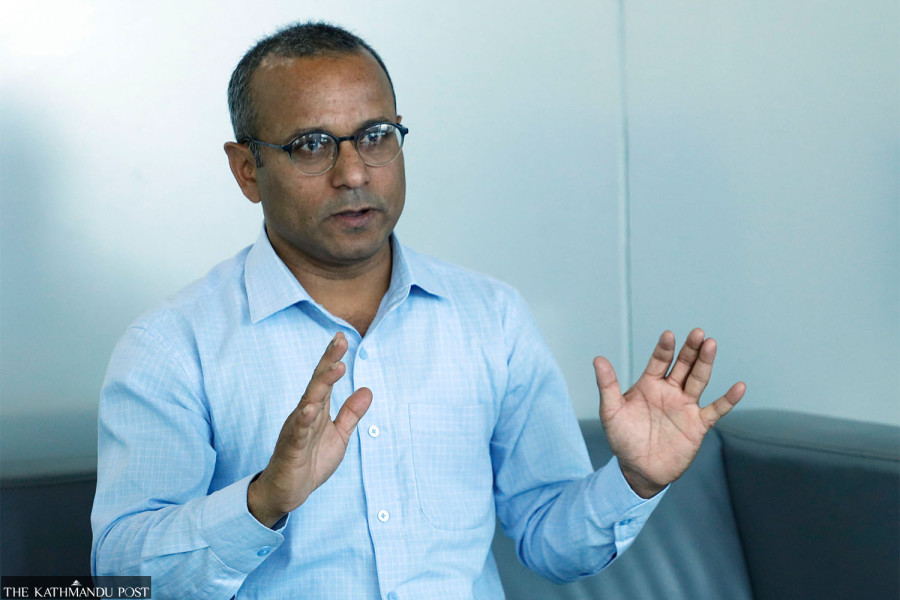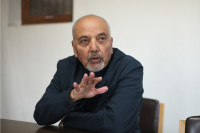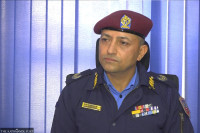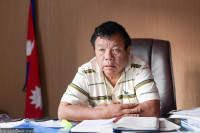Interviews
Direct election of prime minister and chief ministers way out of instability
Just like a set of elite people has captured Kathmandu’s politics, another set of elites has captured the politics of Janakpur, the capital of Madhesh Province.
Thira Lal Bhusal
Political parties’ unhealthy activities to form provincial governments has taken the form of an ugly competition and increased the public’s frustration with the provinces. Separately, leaders of major political parties have started to blame the mixed electoral system for Nepal’s perpetual instability. The Post’s Thira Lal Bhusal talked to political analyst Tula Narayan Shah to discuss these and other related issues.
Nepali politics has entered yet another phase of endless bickering over power after the March 4 change of the ruling coalition. Politicians have resorted to every possible tactic to get leadership in provincial governments. How do you analyse this trend?
I am not surprised. It is natural in the kind of parliamentary system that we practise. We adopted the parliamentary model in federal and provincial levels while the one at our local level is similar to the presidential system. Local unit chiefs and deputies are elected directly by the people and they can serve five-year terms. That has ensured stability there. Provincial governments on the other hand are destabilised when there is any change at the centre.
Leaders have started blaming the electoral system for hung parliaments and instability. Is the problem in the system or with our leaders?
Some senior leaders in major parties now blame the electoral system. Even the Commission for Investigation of Abuse of Authority (CIAA) and the Office of the Auditor General have recommended changes in the electoral model, arguing that the current one had promoted corruption in the country. I am not convinced. Politicians argue that no political party could garner a majority in this system and that led to instability. I rather hold politicians’ personal ambition and corrupt political culture responsible.
General secretary of a major political party recently argued that it will be better for national politics to be driven by two political parties. Nepal conducted eight general elections (in 1959, in 1991, in 1994, in 1999, in 2008, in 2013, in 2017 and in 2022) under a multi-party system. Forget the 1959 polls. Of the three polls held in the 1990s, the Nepali Congress got majority in 1991 and 1999. Also, during those years, two parties—the Congress and the CPN-UML—dominated Nepali politics. Did a single-party majority and dominance of two parties provide stability? Not at all.

Rather, personal rivalries of the Congress leaders invited instability. Fast forward to 2017 elections. The UML and the Maoist Centre formed an alliance and jointly fought elections. They later merged to form the Nepal Communist Party, which had a comfortable majority. Again the rivalry of the top leaders within the party caused instability. These instances show that a majority for a single party doesn’t necessarily translate into stability.
I rather see a conspiracy behind blaming the electoral system. In the 1990s, Nepal adopted the first-past-the-post system to elect all lawmakers. Around 70 percent national seats were controlled by two castes—Brahmin and Chhetri. In 2008, we adopted a mixed electoral system, which was a demand of the 2006 people’s movement, the Maoist insurgency and the Madhesh agitation. The proportional representation category significantly increased representation of women, dalits, Madheshi and indigenous communities in the legislature, whereas the representation of the males of Khas-Arya groups, who were historically ruling the country, decreased drastically.
Who are those elected the most under the FPTP system?
The FPTP electoral system has certain attributes that are more conducive to some groups than others. ‘High-caste males’ win more elections. Females have less of a chance. But dalits also have less chance even if the candidate is male. Those like contractors, landlords and businesspeople who can freely spend win elections. Likewise, those who are well-connected with the power centres in Kathmandu can influence elections. Chhetris and Thakuris were dominant in Panchayat politics. Brahmins got stronger after the 1990 political change. Also those who have access and visibility in media and other public forums have better chances of being elected under the FPTP.
Some leaders who have these capabilities have won elections in different systems. There is one Madheshi leader, who won election in Panchayat, got tickets from Congress and won again in the multiparty system. Later he joined a Madhesh-based party and won. So, high-caste males and those with access to power corridors in Kathmandu want FPTP. Whereas, women, dalits and those from marginalised communities prefer PR.
A general perception is that those who are directly elected are competent ones and can deliver whereas those from the PR category are there just for the sake of representation. Do you agree?
Leaders didn’t pick the candidates properly under the PR category. They picked their loved or loyal ones or sold these seats for hefty monetary returns. Leaders from Madheshi and indigenous communities fought for this system. But the same Madheshi leaders kept the names of their wives, daughters and other family members at the top of the PR list. Thus leaders misused and defamed the electoral system. So, the debate should be focused on correcting the wrong practices, not scrapping the system itself.
Provinces replicated all the wrong practices of the centre and did even worse.
We adopted the same parliamentary system in provinces. So the same thing happened there. Conversely, local units are different as the system there is different. Therefore, we have to go for directly elected executive heads at the centre as well as provinces. Let’s elect the prime minister and chief ministers directly. That will give us stability. Senior leaders from the Congress, the UML and the Maoist Centre have proposed changing the electoral system but they haven’t proposed direct election of the prime minister and chief ministers. So, the solution is direct election of executive heads, as in Palikas. Scrapping of the PR system won’t help.
What if a wrong person gets elected to the post and can’t be removed for five years?
In a democracy, you have to trust the people. Nepali citizens are the ones who removed monarchy. Can’t they unseat a leader elected by their votes? In a direct election, even a person from outside the political parties may emerge. So, politicians are afraid because traditionally they exert control over candidacy and various other things through the parties.

Many think of provinces as an unnecessary burden on state coffers. Is that the case?
I don’t think so. State restructuring was one of the major demands of the Maoist insurgency, Madhesh movement and the 2006 People’s Movement. Why did they ask for it? Because Nepal was a heavily centralised state and it wasn’t inclusive. Federalisation of the state, inclusive electoral system and reservation quotas in civil service were the three components of state restructuring.
But why did the provinces then fail to deliver and win public trust?
The stakeholders spent around a decade deciding what type of provinces should be carved out. Even pro-federalists didn’t debate how to make the provinces functional. Those who lobbied in favour of the federal system have now become defensive. Some are silent. The political party [which is led by Upendra Yadav] that fought for the federal system has been leading the government in Madhesh for the past six years. But they haven’t given any relief to the common people through the provincial government. People have an impression that the provincial system has added corruption and it is only for the leaders and their cronies, not the common people.
Are the leaders really corrupt or do they lack efficiency?
Even the Maoist and Madheshi parties that promised to be different to the Congress and the UML couldn’t come up with a roadmap to make the federal system and state agencies more meaningful for the people. They only indulged in power politics, just like other parties. That frustrated the people.
You recently travelled to various parts of Madhesh province. How are the sub-national administrations working and what is the public mood there?
A society where people are aware, educated and active helps make leaders as well as administration accountable. Authorities are found to be working arbitrarily in the places where people can’t question their wrongdoing. We find relatively better administration in the mid-hill regions, where Brahmins and Chhetris have dominant presence as they have better understanding of the system, laws and other information. Such a mid-hill area expands from the eastern border to Lumbini Province. In this belt, people can raise questions and make the administration accountable. Women’s status is better while caste-based discrimination is less. Local units, schools, health posts, and administrative units work well. Conversely, these aspects are weak in Karnali, Sudurpaschim, inner Madhesh and in the northern belt as there is no critical mass capable of questioning the authorities.
You should understand that there are two Madhesh belts. One is along the East-West Highway, second is the bordering area. The belt along the highway has a diverse social composition. There is dominance of the people who migrated from the hills. Development indicators are better and so is the presence of state agencies. The more you move south, the more you find homogenous populations of Madheshi origin. Traditional power relations haven’t changed there. Patron-client dynamics still stand. Certain individuals have key roles in elections and other important activities. They take the decision on behalf of other common people. We find similar practice in the northern belt as well but not in the mid-hill and highway areas.
Many say local units perform better than provinces. What is the perception on the ground?
Local level is equipped with needed authority. Provinces should be given powers to make them effective as per the spirit of federalism. The present system was designed by reluctant federalists. Therefore, what we need is a fresh debate on the reforms of provinces.

There are two conflicting claims. A section of the society says provinces have misused their authority and failed to deliver. Others say the provinces need more authority for effective functioning.
It is true that provinces have failed to use the authority they have. Provinces have their legislatures that prepare their budgets and their governments can implement it. Give me an example of an exemplary and innovative initiative taken by any of the seven provinces in the past six years. Madhesh Province started the ‘Beti Padhau Beti Bachau’ campaign but corruption doomed it. People started raising questions, “why do we need provinces, if the leaders there are to copy the same corrupt activities of the centre?”
Madheshi leaders opposed the hill people’s dominance and discriminatory practices in the central administration. But the same Madheshi leaders aren’t promoting an inclusive system in Madhesh. Around 20 percent of the total Madhesh population are dalits. The government in the province has changed multiple times. But how many dalits have been ministers in the provincial Cabinets? There are 136 local units in Madhesh Province. But only one mayor and two deputy-mayors are from the dalit community. Just like a set of elite people has captured Kathmandu’s politics, another set of elites has captured the politics of Janakpur.
How do Madheshi people look at provinces?
People in Kathmandu, mid-hills, and some other places can be heard saying provinces should be scrapped. Common people in Madhesh don’t say so. But they have dissatisfaction with the parties who championed the federal system. They say, “our lives are the same even in the federal system”.
How do you analyse the performance of two new parties in Madhesh—Janamat Party and Nagarik Unmukti?
Overall, three parties emerged from the 2022 elections. The Rastriya Swatantra Party emerged from the areas with a dominant presence of hill people. The Janamat Party won from eastern Tarai and the Nagarik Unmukti Party from the western part of the southern belt. The Janamat says the agenda of discrimination against Madhesh is still relevant but they oppose the leadership of the Janata Samajbadi Party and the Loktantrik Samajbadi Party. The old Madheshi parties spoke against Kathmandu’s discrimination but they themselves didn’t work to remove discrimination when they led the government in Madhesh. Besides, they didn’t speak against bad governance. Now, the Janamat’s agenda is to fight discrimination and bad governance, both by Kathmandu as well as the old Madheshi parties.
The RSP’s emergence is against “the bad governance of the Congress and the UML”. Its major agenda is good governance. It doesn’t care about discrimination. But bad governance isn’t an agenda of Nagarik Unmukti. The party that emerged mainly after the Tikapur incident is against the discrimination of Tharu community. The dispute in the party is family-based and the outfit hasn’t taken the form of a political party.




 10.12°C Kathmandu
10.12°C Kathmandu












